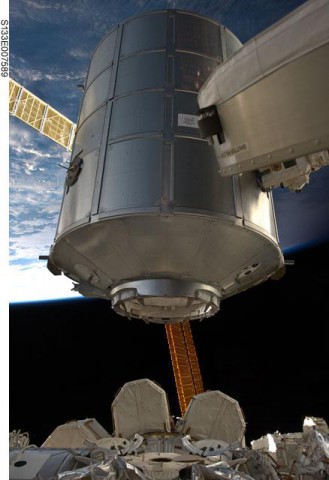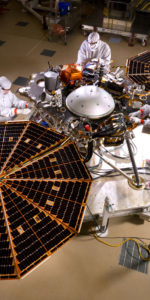
The U.S. Orbital Segment (USOS) of the International Space Station (ISS) looks more like a flat-bottomed boat tonight, following Wednesday’s successful unberthing and relocation of the Leonardo Permanent Multipurpose Module (PMM) from the Earth-facing (or “nadir”) port of the Unity node to the forward port of the Tranquility node. As detailed in a recent NASA animation, the multi-hour operation—executed by the space station’s 57.7-foot-long (17.6-meter) Canadarm2 robotic arm—was performed under the auspices of the Robotics Officer (ROBO) in the Mission Control Center (MCC) at the Johnson Space Center (JSC) in Houston, Texas, and supported by the incumbent Expedition 43 crew, and was complete by 9:08 a.m. EDT. It represents the first step in a complex effort to reconfigure the USOS with two docking ports for future Commercial Crew vehicles and two berthing locations for unpiloted visitors.
“Since we’re moving the Permanent Multipurpose Module, maybe we should rename it,” quipped the Canadian Space Agency (CSA) in a characteristically humorous tweet, earlier today. “How about the Not-So-Permanent Multipurpose Module?” The Italian-built Leonardo began its operational life as the first Multi-Purpose Logistics Module (MPLM) and launched aboard the shuttle on eight occasions between March 2001 and its permanent installation on the ISS in February 2011. On each of its visiting shuttle flights, it delivered payloads and supplies to various ISS crews, before embarking on its current mission as a spare parts and storage depot. Weighing 22,000 pounds (10,000 kg), it measures 22 feet (6.7 meters) long and 14 feet (4.2 meters) in diameter.

As described in a recent AmericaSpace article, the Leonardo PMM relocation was originally supposed to occur in mid-June, but was brought forward to 27 May when the ISS manifest was realigned after the Progress M-27M failure. The Soyuz TMA-15M crew’s stay aboard the station was extended from 14 May until 11 June, and the arrival of the Soyuz TMA-17M crew has been delayed from 26 May until 24 July, producing a relatively spacious period of several weeks to get the relocation tasks underway.
Yesterday (Tuesday), Expedition 43 Commander Terry Virts and Flight Engineer Scott Kelly concluded a heavy period of internal systems reconfiguration, removed power and data jumpers and closed the nadir hatch of Unity’s Common Berthing Mechanism (CBM) to seal off the Leonardo PMM. Early this morning, CSA—whose Canadarm2 would be doing much of the grunt work of the relocation—tweeted: “Moving Day. No boxes, packing tape or twine required! #Canadarm2 is relocating the Permanent Multipurpose Module. So who pays for the pizza?” Humor aside, the activity was labor-intensive and prompted Scott Kelly to remark to his 155,000 Twitter followers: “Busy day today. I’ll tell you all about it.”
Today’s relocation ran smoothly, executed entirely robotically by the ROBO at MCC-Houston, working in tandem with the Mobile Servicing System (MSS) Operations Center at CSA’s headquarters in St. Hubert, Quebec. The Canadarm2 robotic arm—which had earlier moved to a new base on the Power and Data Grapple Fixture (PDGF) on the U.S. Destiny laboratory module, in support of the task—grappled the Leonardo PMM and Virts and Kelly commanded the 16 CBM bolts to open. This enabled the giant module to begin its move at shortly after 6 a.m. EDT. A little over two hours later, CSA tweeted that it was in position near to the Tranquility forward port, allowing Virts and Kelly to activate a series of latches and bolts to secure it in place. By 9:08 a.m. EDT, the Leonardo PMM was safely buttoned up at its new home.

Current plans call for the module to be reopened tomorrow morning (Thursday), and it is coincidental that one of the astronauts to do so will be Kelly, who was also aboard the ISS as Commander of Expedition 26 and opened the Leonardo PMM when it first arrived as a permanent addition to the space station, back in February 2011. Congratulations poured in, with Canadian astronaut Jeremy Hansen tweeting: “#ISS rearrangement complete, like moving a room 2 other side of house. Delicate task 4 #Canadarm2. Prep 4 new rockets.” Later, veteran NASA astronaut Karen Nyberg added: “Congrats to @Space_Station team on successful module relocate to make way for @Commercial_Crew Spacecraft!” Praising his own team, Expedition 43 Commander Terry Virts thanked his crewmate, Russian cosmonaut Gennadi Padalka, for producing spectacular on-board video of the relocation.
Until today, and with the exception of the small cupola, the Leonardo PMM was the only “downward-facing” module on the USOS. As a consequence, its relocation to Tranquility forward will provide it with a virtually unobstructed view from the multi-windowed cupola across the “bottom” of the entire U.S. segment of the ISS. This will offer critical visibility for crew members in the coming months and years, as the nadir interfaces of both the Unity and Harmony nodes see heavy use as berthing locations for the station’s unpiloted visitors, including Japan’s H-II Transfer Vehicle (HTV), SpaceX’s Dragon and Orbital Sciences’ Cygnus. On 23 August, the HTV-5 mission will berth at Harmony nadir, then be robotically transferred to Unity nadir on 31 August. This will allow SpaceX’s CRS-8 Dragon to berth directly at Harmony nadir on 4 September, thereby marking the first occasion that as many as two unpiloted visiting vehicles have berthed simultaneously at the USOS.
With CRS-8 scheduled to depart the space station on 4 October, the original plan was for HTV-5 to be robotically relocated from Unity nadir to the now-vacant Harmony nadir on 7 October, after which it would unberth and commence its final separation. “HTV needs to berth and unberth from Harmony, due to proximity ops equipment interference,” NASA’s Rob Navias told AmericaSpace, back in March. More recently, it appears that the need for this two-step process has been eliminated. “Further analysis has indicated that HTV could depart from either Unity or Harmony,” Mr. Navias explained in mid-May. “The possible plan to relocate HTV from its initial berthing port at Harmony nadir to Unity nadir is designed to accommodate two visiting vehicles at the USOS segment at the same time, like we will ultimately see anyway once Commercial Crew operations begin. In this case, the preliminary plan would be to relocate HTV to accommodate Dragon CRS-8 at Harmony nadir, but time will tell whether that will be needed at this time.”
With the Leonardo PMM thus relocated, the first stage in a complex sequence of events to reconfigure the ISS for Commercial Crew operations is now complete. On 26 June, SpaceX’s CRS-7 Dragon cargo mission will deliver the first of two International Docking Adapters (IDA-1), which will be installed onto the Pressurized Mating Adapter (PMA)-2 at the forward end of the Harmony node, during a joint robotics/EVA operation, likely in early August. This location will serve as the primary interface for Commercial Crew vehicles. Later in the year, PMA-3 will be relocated from its present perch on the Tranquility node over to the space-facing (or “zenith”) side of the Harmony node, thereby providing a location for IDA-2 to be installed when it is delivered to orbit aboard SpaceX’s CRS-9 Dragon in December. The latter will serve as a backup Commercial Crew docking interface.
Want to keep up-to-date with all things space? Be sure to “Like” AmericaSpace on Facebook and follow us on Twitter: @AmericaSpace





One Comment
One Ping
Pingback:Second-Longest Space Station Expedition to End Thursday « AmericaSpace